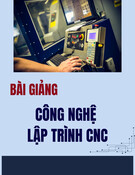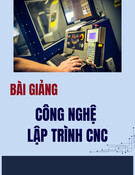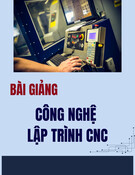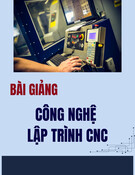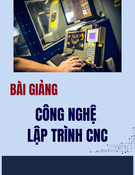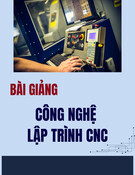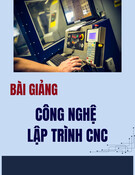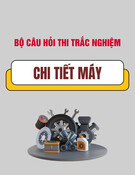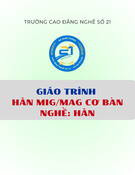
Journal of Science and Technique - Vol. 19, No. 03 (Nov. 2024)
32
DETERMINING IMPACT VELOCITY IN AN IMPACT TESTER
USING A MATHEMATICAL MODEL
Ba Binh Phan1,*, Van Yen Duong1
1General Department of Defence Industry
Abstract
Testing on impact test hammer is one of the methods to evaluate the impact of impulses,
accelerations, and stress waves on the details and parts of the test object in order to evaluate
the operation or durability of the test object for research and testing. Those impacts depend
on many factors such as the weight of the hammer, the weight of the test object, the hardness
of the anvil, the angle of lifting the hammer, etc. The parameters of the hammer are only
applicable to the default cases, other cases when necessary to determine velocity must be
measured. The calculation method is suggested by this article to determine impact velocity
so that it can be applied on all cases instead of having to measure many times. The calculation
results are verified by experimentally measuring the hammer velocity on high-speed camera
with an error not exceeding 3.42%.
Keywords: Impact test hammer; material durability test; bounce velocity; impact acceleration.
1. Introduction
Testing on impact test hammer is one of the impact assessment methods of
impulses, accelerations, and stress waves on the components and parts of the test object
in order to assess the operation or strength of the test object depending on the purpose of
the test.
Weapons test includes many researches that require different velocity ranges when
impacting. From the impact velocity and impact conditions (hammer material, anvil
material), the impact acceleration, bounce rate due to the impact of stress waves on a
certain moving part [1-3] or assess the strength of the part for research and testing.
Impact test hammers in the market are often used to measure the strength of
materials, so their impact velocity is usually minor, size of 4 - 8 m/s [4-6]. These types of
devices are not suitable for weapons research. Impact test hammer under research has a
large velocity range (corresponding to each adjustment step on the hammer, referred to
as teeth) that is suitable for many researches in the military field. For each tooth, the
velocity of the hammer will be different in proportion to the mass of the jig to be installed
on the hammer. Experiments show that large variations in acceleration values or stress
* Corresponding author, email: panboping1976@gmail.com
DOI: 10.56651/lqdtu.jst.v19.n03.859

Tạp chí Khoa học và Kỹ thuật - ISSN 1859-0209
33
waves are received at the same collision conditions when the velocity changes only
slightly. Therefore, the calculation and determination of hammer velocity to form the test
is of great significance in the process of research and testing.
The auxiliary parts of the impact test hammer are only suitable for certain cases.
The impact velocity of other cases are determined by measuring. Instead of measuring
multiple times, the hammer velocity calculating method and program is suggested by this
article for general cases and the input parameters will be changed for the other cases.
The calculation results are verified by using a high speed camera to measure the
hammer velocity.
2. Structure and operation of impact test hammer
In Fig. 1, the impact test hammer consists of the following components: the hammer
(1), the hammer handle (2), the roller (3) fastened together to form a rigid block (rotary
unit) that rotates around O central line. The sample (4) fastened to the hammer to receive
mechanical impacts when the hammer hits the anvil (5). The weight (6) is hung on a
zipper (7) wound on the profile of the roller.
Fig. 1. Principle diagram of the impact test hammer
1 - hammer; 2 - hammer handle; 3 - roller; 4 - test objects; 5 - anvils; 6 - weights; 7 - rope.
During the test, the sample is mounted on the hammer, the lower the position of the
hammer is, the larger the rotation angle of the hammer is, so the velocity and acceleration
obtained are higher. Depending on the test requirements, the initial position of the hammer
is selected. The initial position of the hammer (corresponding to the initial rotation angle of
the roller) is determined through preset notches on a ratchet mechanism, locking pin,

Journal of Science and Technique - Vol. 19, No. 03 (Nov. 2024)
34
referred to as the hammer teeth. Each tooth of the ratchet corresponds to each initial
rotation angle of the roller. The ratchet is divided into 30 teeth, the angle between two
teeth is 12°. As the hammer shaft cannot rotate a full circle as it is stuck in the anvil, the
hammer can only be tested from tooth number 1 to tooth number 23. Before testing, the
hammer is fixed with a locking pin. When the locking pin is released, under the effect of
load, the rotary unit returns to the position where the hammer head hits the anvil.
Through the impact, the details and structures of the test object receives the necessary
mechanical parameters.
3. Differential equation of mechanism motion and calculation results
The impact test hammer is considered as a mechanism consisting of a weight,
hammer, hammer handle, and roller. The hammer, hammer handle and roller are fastened
together, the rotation motion is a fixed axis; The weight moves vertically under the effect
of gravity.
The circular arc of the roller consists of two parts: The large arc has an O1 central line
of radius R, and the small arc at the beginning has an O central line of radius r0 (Fig. 2). These
arcs produce various motion phases of the weight:
- The first phase: When the rope extends on the large arc (From the initial position
to the position where the line connecting the central line of rotation and the circular
central line of radius R coincides with the Ox axis), the weighty object engages in two
motions: vertical motion and horizontal motion.
- The second phase: When the rope protrudes on a small arc (From the position
where the line connecting the central line of rotation and the circular central line of
radius R coincides with the Ox shaft to the position where the hammer hits the anvil) the
weighty object only moves vertically.
In the case the weighty object motion is viewed in two directions, Ox and Oy.
It is supposed:
- Ignore the oscillation (shaking) of the weighty object during the motion of the system.
- Ignore the weight of the rope (5) and consider the rope to be inelastic and
always vertical.
Equation of momentum moment variation of mechanism [7]:
12ms
dQ
Q M M M
dt
(1)
in which
1
M
is the gravitational moment of the weighty object with respect to the spin:

Tạp chí Khoa học và Kỹ thuật - ISSN 1859-0209
35
1
M Mgx
(2)
in which M is weighty object mass,
g
is gravitational acceleration,
x
is lever arm
of gravity.
-
2
M
is the gravity moment of the hammer handle, hammer and roller for the spin:
2 1 0 0 2 0 0 3 1 0 0
1 2 0 0 3 1 0 0
1
cos( ) cos( ) ( )
2
1
( ) cos( ) cos( )
2
M m gl m gl m gl
m m gl m gl
(3)
in which m1, m2, m3 are the weight of the hammer, hammer handle and roller,
l
is the
length of the hammer handle,
1
l
is the distance from the barry centre of the roller to the
spin,
0
is the angles between the hammer handle and OO1 central line,
0
is
1
GOO
angle, G is the center of gravity of the roller.
a) First phase b) Second phase
Fig. 2. Motion phases of mechanism.
- Mms is the moment of friction at the rotary bearing [8]:
0
2
1
ms
fT
M
f
(4)
in which f is friction coefficient, T is combined force acting on the rotating joint:
T = (M + m1 + m2 + m3)g,
0
is spin radius.
- Q is the momentum moment of mechanism:
12
Q Q Q
, in which

Journal of Science and Technique - Vol. 19, No. 03 (Nov. 2024)
36
+ Q1 is the momentum moment of the rotary unit (including: hammer, hammer
handle and roller):
1 1 2 3
()
kq
Q J J J J
kq
J
is the total inertia moment of the rotary units; J1, J2, J3 is the inertia moment of the
hammer, hammer handle and roller.
+
2
Q
is the momentum moment of the weighty object:
2()Q M xy xy
Therefore:
()
kq
Q J M xy xy
(5)
From (1) and (5), a differential equation of mechanism motion:
12
[ ( )
kq ms
dJ M xy xy M M M
dt
12
()
kq ms
J M xy xy M M M
(6)
where
dx
x ; y x
d
2
22
2
d x dx dx
x , y x
d d d
Replace
,xy
to equation (6), the outcomes are:
2
22
12
2
( ) ( )
kq ms
dx dx d x
J M x y M x y M M M
d d d
(7)
The mechanism motion is divided into 2 phases (Fig. 2).
- First phase: The weighty object participates in 2 motions, the coordinates of the
centre of the weighty object:
00
0 0 0
( ) ( )cos( )
( )sin( )
x r R R r
y R r H R
(8)
in which H0 is the initial protruding piece of the rope, corresponding to each angle
0
(corresponding to each tooth on the hammer) for a value H0.







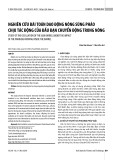

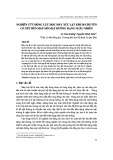
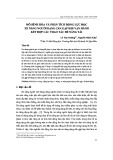
![Bài tập tối ưu trong gia công cắt gọt [kèm lời giải chi tiết]](https://cdn.tailieu.vn/images/document/thumbnail/2025/20251129/dinhd8055/135x160/26351764558606.jpg)




